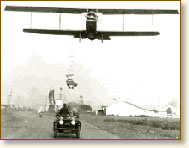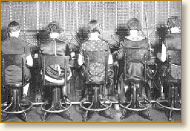The Changing World of Work
Before the Industrial Revolution, men worked in small shops with and for their
employers in a relaxed atmosphere. They developed a personal relationship that
in many ways was family-like. Conversation, singing, and dipping into the nearby
rum barrel for a periodic drink were common
 |
Hollywood stuntman "Fearless
Freddie" attempts the 1st jump
from a plane to a car at 78 mph
Nov. 20, 1920 |
sounds and sights. Single women generally
stayed with their families until they married, helping with the household duties,
but some worked as domestic help. Married women stayed at home attending to domestic
chores. Preparing three meals a day took up most of the day.
Railroads not only created a transportation revolution but also a management revolution that altered the workplace dramatically. Army officers hired by railroads to help with construction and management instituted an organizational structure similar to that of the army's. Efficiency and profit were the top priorities. Managers had to coordinate several trains over a wide region so that they would run on time and not collide. The railroad industry standardized time and established time zones as part of this effort. The sheer size of a company meant workers no longer had a personal relationship with their bosses. They now answered to someone in middle management.
By the turn of the century, most industries had adopted these same management
practices. Workdays were now punctuated with the blowing of the work whistle
or the chiming of the town clock. Workdays in most industries averaged ten
hours, and work weeks over sixty. Steel workers saw the longest workdays. They
worked twelve-hour shifts for six days, worked a 24-hour shift on the seventh
day, and then worked six more twelve-hour days so that they may have off the
fourteenth day. Workers tolerated these conditions because there was always
someone ready to take their position on the factory line.
Owners implemented scientific management practices on the factory floor. By conducting time-motion studies of workers, managers decided how long a task took to complete and the minimum number of steps it required. The goal was to improve the efficiency of the workers and increase production. Workers were not pleased. Already
 |
| Telephone operators, 1927 |
resentful over lowered wages, longer workdays, and the loss of skilled positions, some responded by organizing labor unions to fight back, but with little success.
The creation of middle management allowed women to enter the work force in large
numbers for the first time. They filled the clerical and secretarial positions
left open by men now in middle management. Besides office jobs, city girls
worked as clerks in department stores. Despite long hours of standing at attention
and waiting on impatient middle-class women, a department store job was one
of the most desired jobs. Ironically, stores expected clerks to promote and
wear the latest middle-class fashions while paying them subsistence wages.
During both world wars, women took over many traditional male jobs in construction,
but were forced out of those jobs after the wars ended. Still other city workers
often turned their homes into a workplace by doing some sort of assembly work.
Regardless of where a person worked, the workplace had changed forever.
References:
Dubofsky, Melvin, Industrialism and the American Worker, 1865-1920 (1985, 2nd. ed.)-, Wertheimer, Barbara, We Were There: The Story of Working Women in America (1977); Porter, Glenn, The Rise of Big Business, 1860-1920; (1992, 2nd. ed.)
How To Cite This Article:
"The Changing World of Work," EyeWitness to History, www.eyewitnesstohistory.com (2000).
|






